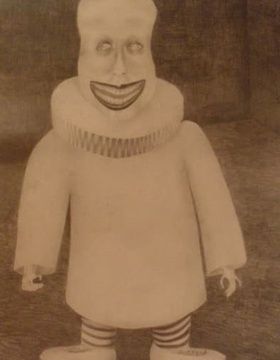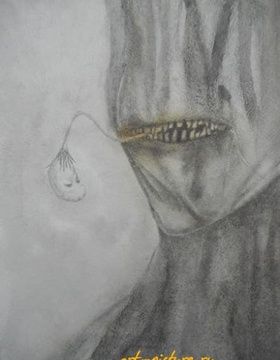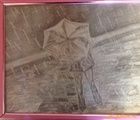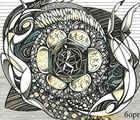
Начиная с 14 века, художники использовали для рисования палочки, изготовленные из смеси свинца с цинком, которые иногда называли "серебрянными карандашами". Грифельные карандаши известны с 16 века.
В ту ночь 1565 года в английском графстве Камберленд разыгралась буря. Непрерывно лил дождь, а порывы ветра были настолько сильны, что даже молодые крепкие деревья пригибались к земле. Не удивительно, что наутро жителям пришлось убирать с дороги много вырванных с корнем старых деревьев. Под одним из них обнаружили какой-то не встречавшийся ранее черный камень.
Прошло не так уж много времени, и королевским указом этот камень категорически запретили вывозить из Англии. Кроме того, камень разрешалось добывать только шесть недель в году. Нарушителей ждала смертная казнь... Что же это за камень, который стоил дороже человеческой жизни? Он не являлся самоцветом или алмазом, хотя находился с последним в «родственных отношениях». А ценился он за одно качество: удивительно мягкий, он оставлял четкие черные следы на ткани, бумаге, светлой коже. Так был найден графит, который стал основным материалом для производства карандашей.
Но, определив непригодность нового материала для изготовления пуль, начали производить из него тонкие, заострённые на конце палочки и использовали их для рисования.
Эти палочки были мягкими, пачкали руки и подходили только для рисования, но не для письма. В 17 веке графит продавали на улицах. Художники, чтобы было удобнее и палочка не была такой мягкой, зажимали эти графиты "карандашами", между кусочками дерева или веточками, обворачивали в бумагу или обвязывали бечёвкой. Первый документ, в котором упоминается деревянный карандаш, датирован 1683 годом. В Германии производство графитных карандашей началось в Нюрнберге. Немцы, смешивая графит с серой и клеем, получили стержень не такого высокого качества, но по более низкой цене. Чтобы скрыть это, производители карандашей прибегали к разным хитростям. В деревянный корпус карандаша вначале и на конце вставляли кусочки чистого графита, в серенине же находился низкокачественный искусственный стержень. Иногда внутренность карандаша и вовсе была пустой. Так называемый "Нюрнбергский товар" не пользовался хорошей репуцацией. Современный же карандаш изобрёл в 1794 году талантливый французкий учёный и изобритатель Николя Жак Контэ.
История карандаша
В конце 18 века английский парламент ввёл строжайший запрет на вывоз драгоценного графита из Камберленда. За нарушение этого запрета наказание было суровым, вплоть до смертной казни. Но несмотря на это, графит продолжал попадать в центральную Европу контрабандным путём, что привело к увеличению его цены. По заданию французского конвента, Контэ разработал рецептуру смешивания графита с глиной и производства из этих материалов высококачественных стержней. С помощью обработки высокими температурами было достигнута высокая прочность, однако ещё более важный факт, что изменение пропорции смеси давало возможность делать стержни раздной твёрдости, что и послужило основой современной классификации карандашей по твёрдости (она указана на карандаше): М (или B - for blackness) - мягкий и Т (или H - for hardness) - твёрдый. Стандартным (твёрдо - мягкий) карандаш помимо сочетаний ТМ или HB обозначается буквой F (for fine point). P.S. В отличии от Европы и России, в США для указания твёрдости используется числовая шкала. В современных грифелях используются полимеры, которые позволяют добиваться нужного сочетания прочности и эластичности, дают возможность изготавливать очень тонкие грифели для механических карандашей (до 0,3 мм).
Шестигранную форму карандаша предложил в конце 19 века граф Лотар фон Фаберкастл, заметив, что карандаши круглово сечения часто скатываются с наклонных поверхностей для письма. Почти две трети материала, составляющего простой карандаш, уходит в отходы при его заточке. Это натолкнуло американца Алонсо Таунсенда на создание в 1856 году металлического карандаша. Графитный стержень размещался в металлической трубке и мог по необходимости выдвигаться на соответствующею длину.
Это изобретение повлияло на развитие целой группы товаров, использующихся сегодня повсеместно. Самой простой конструкцией является механический карандаш с грифелем 2 мм, где стержень удерживается металлическими прижимами (цангами) - цанговый карандаш. Открываются цанги при нажатии кнопки на конце карандаша, что приводит к выдвиганию на длину, регулируемую владельцем карандаша. Современные механические карандаши более совершенны. При каждом нажатии кнопки происходит автоматическая подача участка грифеля. Такие карандаши не нужно затачивать, они снабжены встроенным (как правило, под кнопкой подачи грифеля) ластиком и имеют различную фиксированную толщину линии (0,3 мм, 0,5 мм, 0,7 мм, 0,9 мм, 1мм).
Очень привычное сочетание слов — простой карандаш.
Как оно родилось?
Что обозначает слово «простой»?
Устройство самого карандаша или вид того черного следа, который оставляет грифель?
Но так ли он прост, этот простой карандаш?
Ведь на языке специалистов он именуется по-другому: черно графитовый. Совсем непрост был и жизненный путь этого вроде бы незатейливого устройства для письма и рисования. Его далеким предком можно считать головешку из костра, которой первобытный человек создавал первые шедевры живописи на стенах пещер.
С появлением бумаги потребовались новые средства для письма и рисования. Родились тушь и чернила. Но носить везде с собой пузырек с чернилами, ждать, пока они высохнут, страдать от клякс и плохого качества перьев — занятие не для художников. Поэтому с незапамятных времен живописцы пытались использовать различные подручные средства.
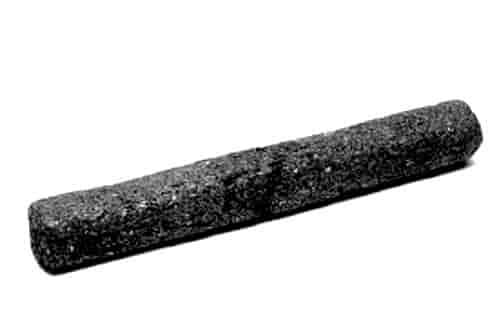 Сохранились сведения, что графитовые стержни для письма и рисования знали уже в Древней Греции. Но с закатом античности стержни, как и многое другое, были забыты человечеством. И когда перед людьми встала проблема, чем рисовать, ее решали проще простого — древесным углем. Можно было взять обгоревший прутик из очага и рисовать. Но это способ для детей. Профессионалам требовались более качественные подручные средства. Им рекомендовалось нарезать сухие и тонкие ивовые палочки, обстругать, заточить с обеих сторон, связать в пучки, а затем: «Возьми новый горшок и положи в него столько, чтобы горшок был полон. Затем возьми крышку и замажь ее глиной, чтобы сделать горшок непроницаемым для дыма. Вечером пойди к булочнику, когда он кончит работу, поставь этот горшок в печь и оставь его там до утра, а утром посмотри, хорошо ли угли прожжены и достаточно ли они черны». Это рекомендация из «Трактата о живописи» Ченнино Ченнини, итальянского живописца эпохи Возрождения.
Сохранились сведения, что графитовые стержни для письма и рисования знали уже в Древней Греции. Но с закатом античности стержни, как и многое другое, были забыты человечеством. И когда перед людьми встала проблема, чем рисовать, ее решали проще простого — древесным углем. Можно было взять обгоревший прутик из очага и рисовать. Но это способ для детей. Профессионалам требовались более качественные подручные средства. Им рекомендовалось нарезать сухие и тонкие ивовые палочки, обстругать, заточить с обеих сторон, связать в пучки, а затем: «Возьми новый горшок и положи в него столько, чтобы горшок был полон. Затем возьми крышку и замажь ее глиной, чтобы сделать горшок непроницаемым для дыма. Вечером пойди к булочнику, когда он кончит работу, поставь этот горшок в печь и оставь его там до утра, а утром посмотри, хорошо ли угли прожжены и достаточно ли они черны». Это рекомендация из «Трактата о живописи» Ченнино Ченнини, итальянского живописца эпохи Возрождения.
Но, несмотря на все ухищрения, уголь все равно оставался углем — он осыпался с бумаги, пачкал руки, легко размазывался по рисунку. Мастера придумывали разные методы борьбы с этим. Например, покрывали бумагу водным раствором клея и высушивали. Затем на этих листах рисовали углем. Когда работа подходила к концу, рисунок держали над паром. В результате клеевой слой увлажнялся и впитывал уголь. А когда рисунок высыхал, уголь оказывался уже довольно хорошо закрепленным.
Другой способ — рисовать металлическими палочками — штифтами.
Он также известен очень давно. Свинец давал линии бледно-серого цвета. Они не годились для рисунка, но вполне подходили для линования строчек под текст. Когда же сделали штифт из материала, в который добавили свинец, то получалась уже более темная линия, которая со временем еще больше темнела под воздействием воздуха. Ее, однако, можно было легко стереть хлебным мякишем или пемзой. Серебряный штифт оставлял темно-серую черту, которая на воздухе коричневела. А вот удалить ее не удавалось ничем, ошибок серебряный штифт не прощал. Понятно, что пользоваться им могли только такие мастера рисунка, которые не проводили ни одной лишней линии. До наших дней сохранились серебряные рисунки Дюрера, Леонардо да Винчи, Лукаса Кранаха.
